Auditing & Assurance Report: Billabong International - Risks Analysis
VerifiedAdded on 2019/10/31
|17
|3991
|86
Report
AI Summary
This report provides a comprehensive analysis of Billabong International, focusing on auditing and assurance principles. It begins with an overview of the company's business operations and its industry context, highlighting key aspects such as the company's global presence, product offerings, and competitive landscape within the surf and apparel market. The report identifies significant business and audit risks faced by Billabong, including translation risk, brand risk, fashion risk, macroeconomic environment risks, social risks, competition, and seasonal factors, along with the potential impact of these risks on the financial statements. The analysis incorporates a review of key financial ratios derived from the company's financial statements, such as current ratio, debt-to-equity ratio, gross profit margin, inventory turnover, and trade receivable turnover, to assess Billabong's financial health and performance. The report concludes with a discussion of material misstatements, going concern considerations, and social responsibility aspects relevant to Billabong's operations, offering insights into the overall audit risk profile and financial reporting quality of the company. The report is designed to help students understand the practical application of auditing and assurance concepts in a real-world business context.
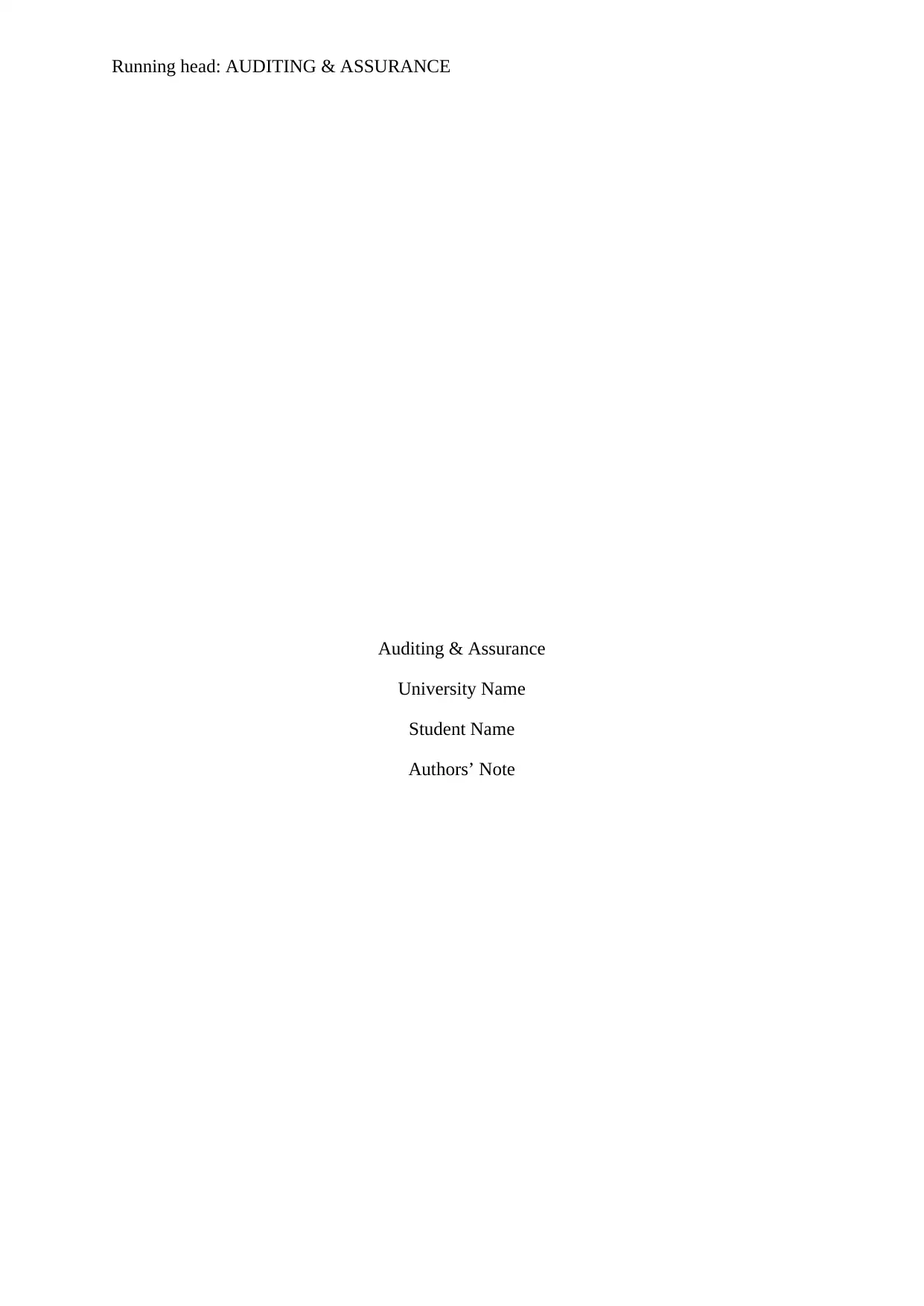
Running head: AUDITING & ASSURANCE
Auditing & Assurance
University Name
Student Name
Authors’ Note
Auditing & Assurance
University Name
Student Name
Authors’ Note
Paraphrase This Document
Need a fresh take? Get an instant paraphrase of this document with our AI Paraphraser
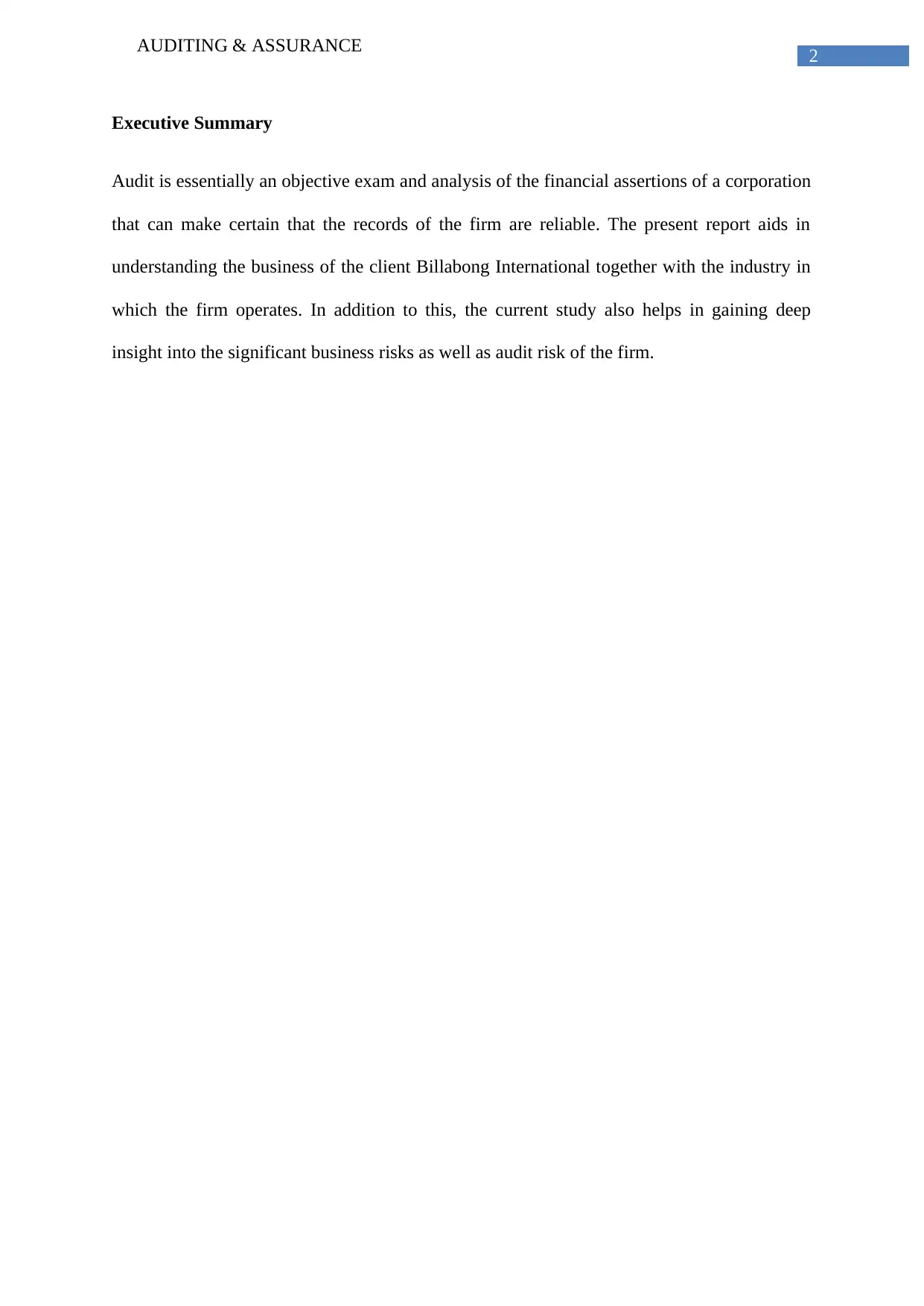
2
AUDITING & ASSURANCE
Executive Summary
Audit is essentially an objective exam and analysis of the financial assertions of a corporation
that can make certain that the records of the firm are reliable. The present report aids in
understanding the business of the client Billabong International together with the industry in
which the firm operates. In addition to this, the current study also helps in gaining deep
insight into the significant business risks as well as audit risk of the firm.
AUDITING & ASSURANCE
Executive Summary
Audit is essentially an objective exam and analysis of the financial assertions of a corporation
that can make certain that the records of the firm are reliable. The present report aids in
understanding the business of the client Billabong International together with the industry in
which the firm operates. In addition to this, the current study also helps in gaining deep
insight into the significant business risks as well as audit risk of the firm.
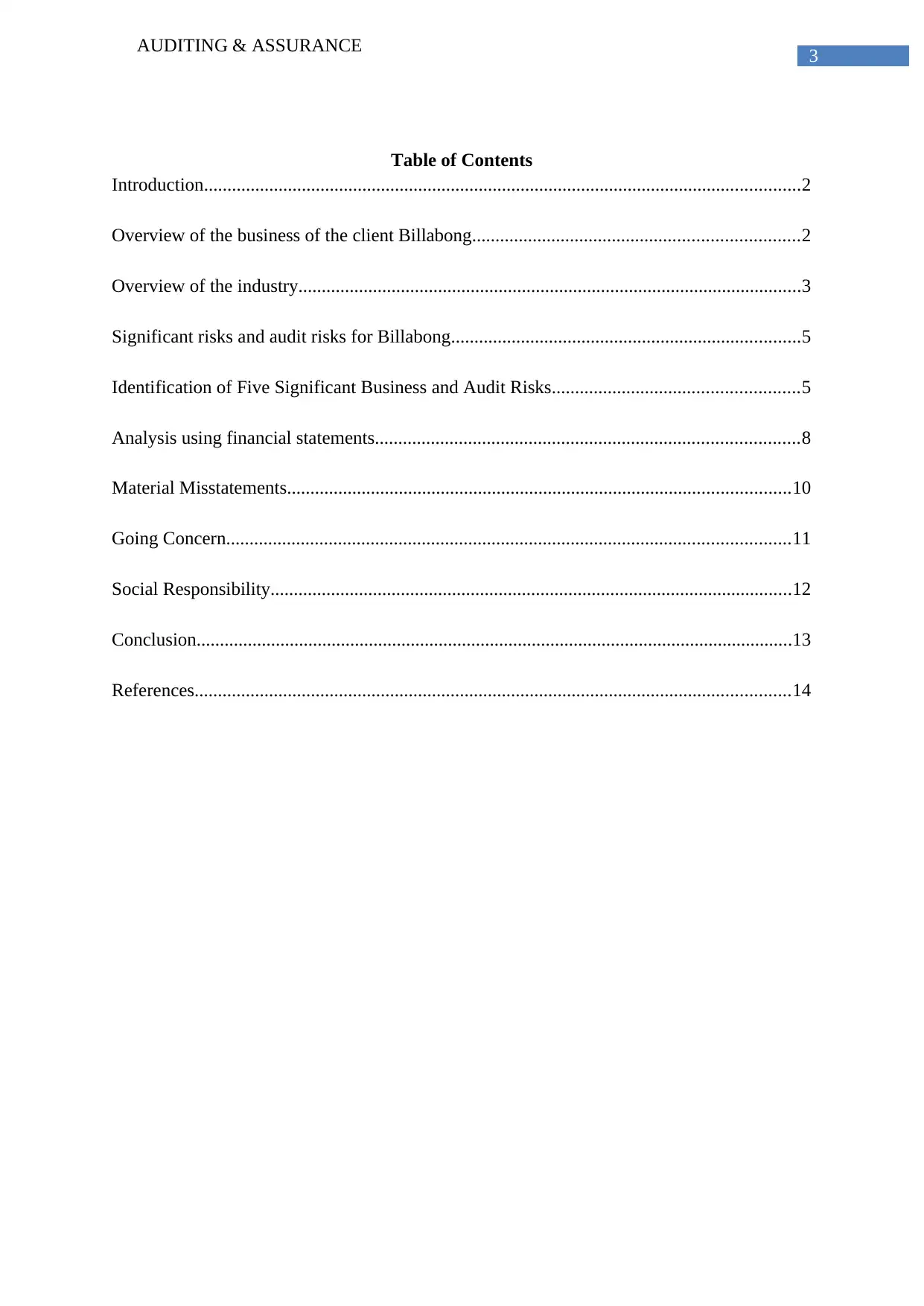
3
AUDITING & ASSURANCE
Table of Contents
Introduction................................................................................................................................2
Overview of the business of the client Billabong......................................................................2
Overview of the industry............................................................................................................3
Significant risks and audit risks for Billabong...........................................................................5
Identification of Five Significant Business and Audit Risks.....................................................5
Analysis using financial statements...........................................................................................8
Material Misstatements............................................................................................................10
Going Concern.........................................................................................................................11
Social Responsibility................................................................................................................12
Conclusion................................................................................................................................13
References................................................................................................................................14
AUDITING & ASSURANCE
Table of Contents
Introduction................................................................................................................................2
Overview of the business of the client Billabong......................................................................2
Overview of the industry............................................................................................................3
Significant risks and audit risks for Billabong...........................................................................5
Identification of Five Significant Business and Audit Risks.....................................................5
Analysis using financial statements...........................................................................................8
Material Misstatements............................................................................................................10
Going Concern.........................................................................................................................11
Social Responsibility................................................................................................................12
Conclusion................................................................................................................................13
References................................................................................................................................14
⊘ This is a preview!⊘
Do you want full access?
Subscribe today to unlock all pages.

Trusted by 1+ million students worldwide
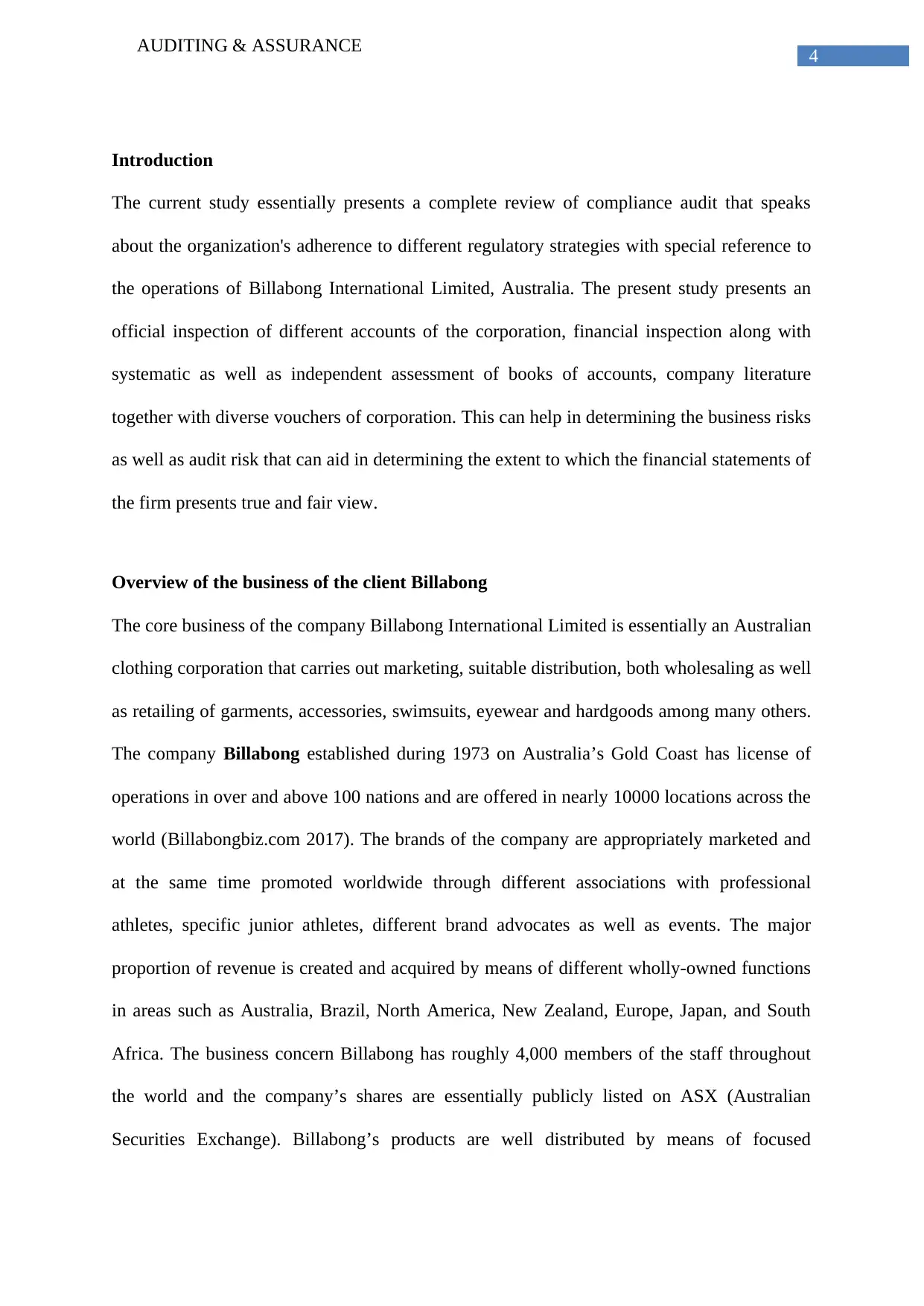
4
AUDITING & ASSURANCE
Introduction
The current study essentially presents a complete review of compliance audit that speaks
about the organization's adherence to different regulatory strategies with special reference to
the operations of Billabong International Limited, Australia. The present study presents an
official inspection of different accounts of the corporation, financial inspection along with
systematic as well as independent assessment of books of accounts, company literature
together with diverse vouchers of corporation. This can help in determining the business risks
as well as audit risk that can aid in determining the extent to which the financial statements of
the firm presents true and fair view.
Overview of the business of the client Billabong
The core business of the company Billabong International Limited is essentially an Australian
clothing corporation that carries out marketing, suitable distribution, both wholesaling as well
as retailing of garments, accessories, swimsuits, eyewear and hardgoods among many others.
The company Billabong established during 1973 on Australia’s Gold Coast has license of
operations in over and above 100 nations and are offered in nearly 10000 locations across the
world (Billabongbiz.com 2017). The brands of the company are appropriately marketed and
at the same time promoted worldwide through different associations with professional
athletes, specific junior athletes, different brand advocates as well as events. The major
proportion of revenue is created and acquired by means of different wholly-owned functions
in areas such as Australia, Brazil, North America, New Zealand, Europe, Japan, and South
Africa. The business concern Billabong has roughly 4,000 members of the staff throughout
the world and the company’s shares are essentially publicly listed on ASX (Australian
Securities Exchange). Billabong’s products are well distributed by means of focused
AUDITING & ASSURANCE
Introduction
The current study essentially presents a complete review of compliance audit that speaks
about the organization's adherence to different regulatory strategies with special reference to
the operations of Billabong International Limited, Australia. The present study presents an
official inspection of different accounts of the corporation, financial inspection along with
systematic as well as independent assessment of books of accounts, company literature
together with diverse vouchers of corporation. This can help in determining the business risks
as well as audit risk that can aid in determining the extent to which the financial statements of
the firm presents true and fair view.
Overview of the business of the client Billabong
The core business of the company Billabong International Limited is essentially an Australian
clothing corporation that carries out marketing, suitable distribution, both wholesaling as well
as retailing of garments, accessories, swimsuits, eyewear and hardgoods among many others.
The company Billabong established during 1973 on Australia’s Gold Coast has license of
operations in over and above 100 nations and are offered in nearly 10000 locations across the
world (Billabongbiz.com 2017). The brands of the company are appropriately marketed and
at the same time promoted worldwide through different associations with professional
athletes, specific junior athletes, different brand advocates as well as events. The major
proportion of revenue is created and acquired by means of different wholly-owned functions
in areas such as Australia, Brazil, North America, New Zealand, Europe, Japan, and South
Africa. The business concern Billabong has roughly 4,000 members of the staff throughout
the world and the company’s shares are essentially publicly listed on ASX (Australian
Securities Exchange). Billabong’s products are well distributed by means of focused
Paraphrase This Document
Need a fresh take? Get an instant paraphrase of this document with our AI Paraphraser
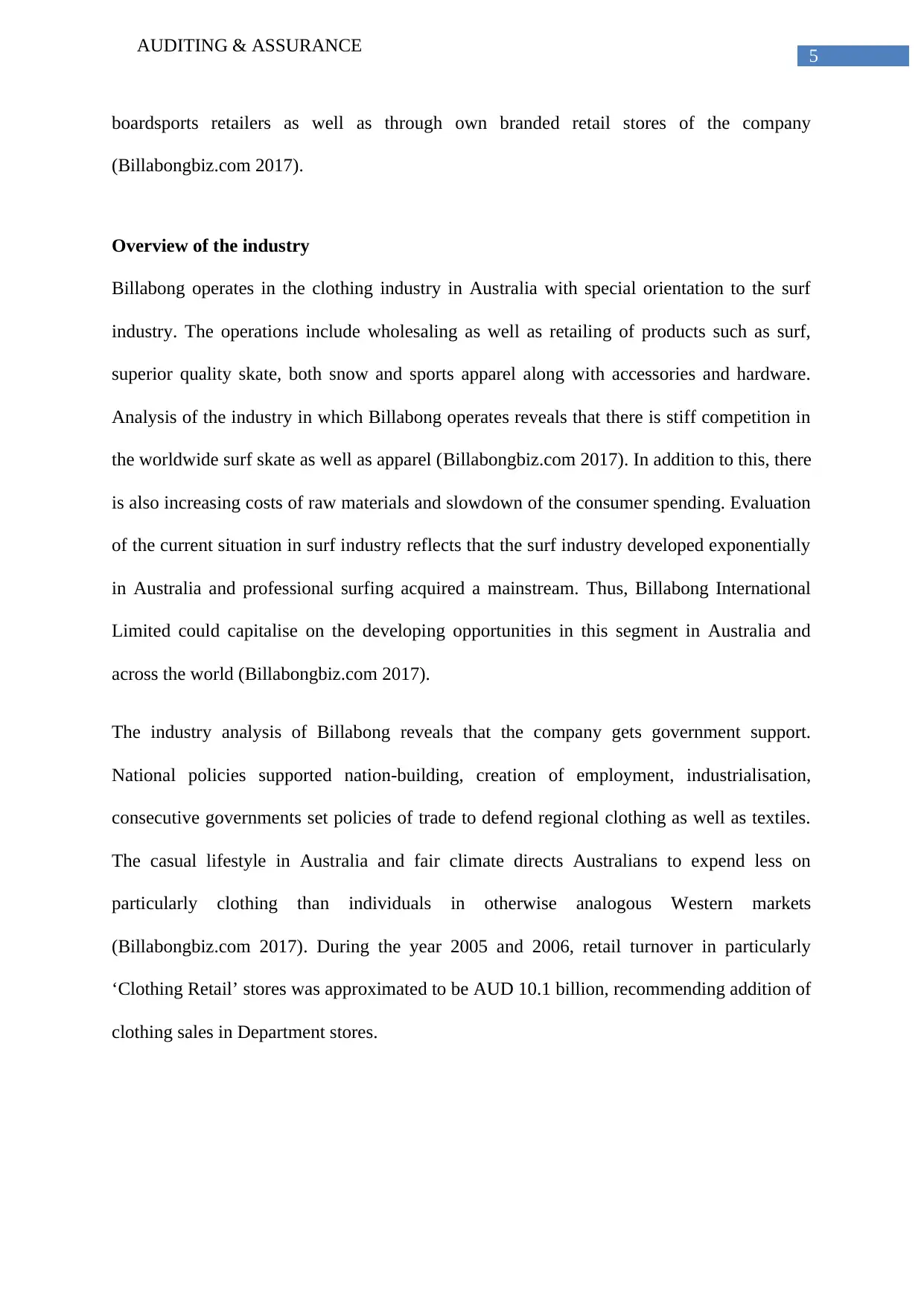
5
AUDITING & ASSURANCE
boardsports retailers as well as through own branded retail stores of the company
(Billabongbiz.com 2017).
Overview of the industry
Billabong operates in the clothing industry in Australia with special orientation to the surf
industry. The operations include wholesaling as well as retailing of products such as surf,
superior quality skate, both snow and sports apparel along with accessories and hardware.
Analysis of the industry in which Billabong operates reveals that there is stiff competition in
the worldwide surf skate as well as apparel (Billabongbiz.com 2017). In addition to this, there
is also increasing costs of raw materials and slowdown of the consumer spending. Evaluation
of the current situation in surf industry reflects that the surf industry developed exponentially
in Australia and professional surfing acquired a mainstream. Thus, Billabong International
Limited could capitalise on the developing opportunities in this segment in Australia and
across the world (Billabongbiz.com 2017).
The industry analysis of Billabong reveals that the company gets government support.
National policies supported nation-building, creation of employment, industrialisation,
consecutive governments set policies of trade to defend regional clothing as well as textiles.
The casual lifestyle in Australia and fair climate directs Australians to expend less on
particularly clothing than individuals in otherwise analogous Western markets
(Billabongbiz.com 2017). During the year 2005 and 2006, retail turnover in particularly
‘Clothing Retail’ stores was approximated to be AUD 10.1 billion, recommending addition of
clothing sales in Department stores.
AUDITING & ASSURANCE
boardsports retailers as well as through own branded retail stores of the company
(Billabongbiz.com 2017).
Overview of the industry
Billabong operates in the clothing industry in Australia with special orientation to the surf
industry. The operations include wholesaling as well as retailing of products such as surf,
superior quality skate, both snow and sports apparel along with accessories and hardware.
Analysis of the industry in which Billabong operates reveals that there is stiff competition in
the worldwide surf skate as well as apparel (Billabongbiz.com 2017). In addition to this, there
is also increasing costs of raw materials and slowdown of the consumer spending. Evaluation
of the current situation in surf industry reflects that the surf industry developed exponentially
in Australia and professional surfing acquired a mainstream. Thus, Billabong International
Limited could capitalise on the developing opportunities in this segment in Australia and
across the world (Billabongbiz.com 2017).
The industry analysis of Billabong reveals that the company gets government support.
National policies supported nation-building, creation of employment, industrialisation,
consecutive governments set policies of trade to defend regional clothing as well as textiles.
The casual lifestyle in Australia and fair climate directs Australians to expend less on
particularly clothing than individuals in otherwise analogous Western markets
(Billabongbiz.com 2017). During the year 2005 and 2006, retail turnover in particularly
‘Clothing Retail’ stores was approximated to be AUD 10.1 billion, recommending addition of
clothing sales in Department stores.
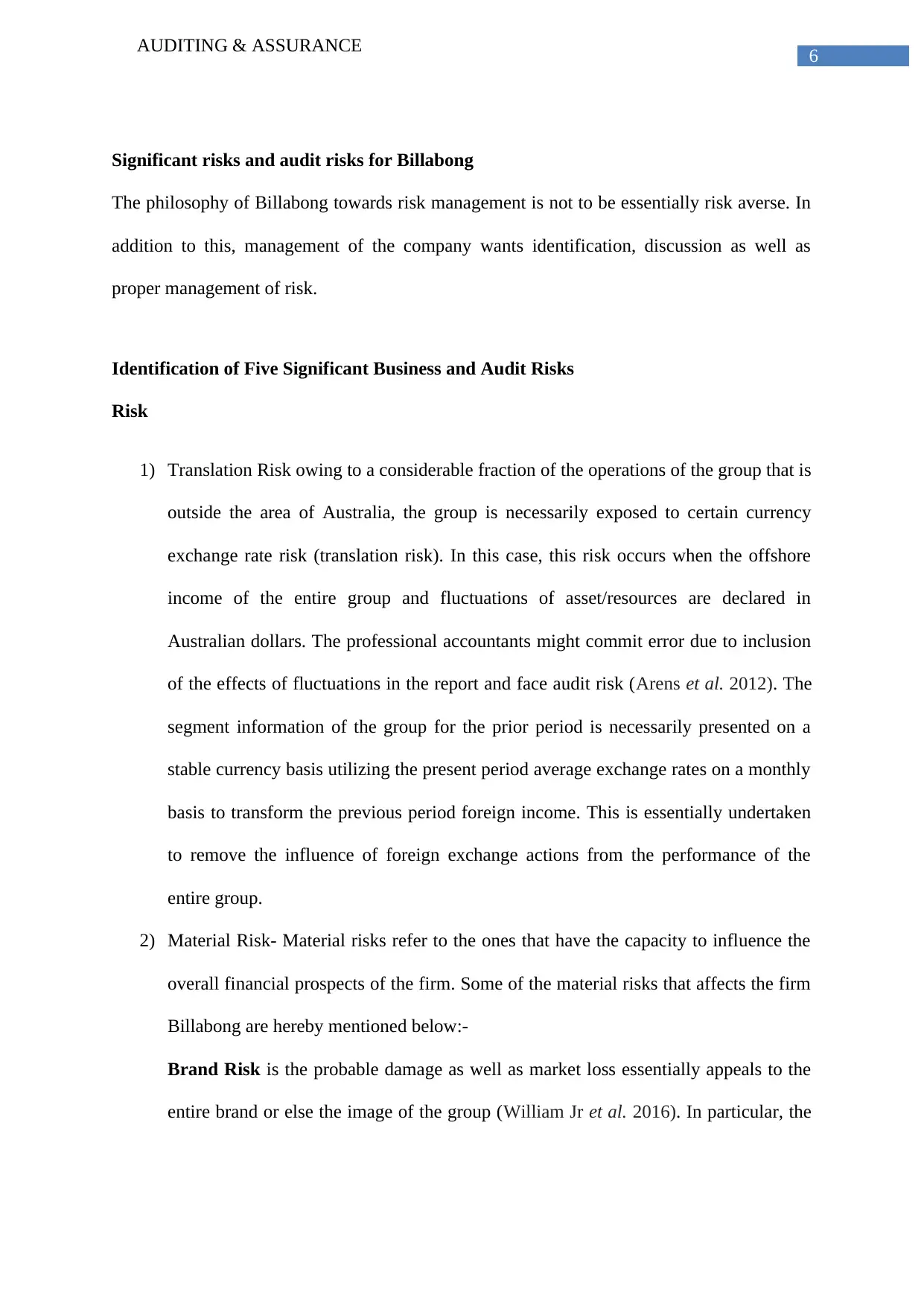
6
AUDITING & ASSURANCE
Significant risks and audit risks for Billabong
The philosophy of Billabong towards risk management is not to be essentially risk averse. In
addition to this, management of the company wants identification, discussion as well as
proper management of risk.
Identification of Five Significant Business and Audit Risks
Risk
1) Translation Risk owing to a considerable fraction of the operations of the group that is
outside the area of Australia, the group is necessarily exposed to certain currency
exchange rate risk (translation risk). In this case, this risk occurs when the offshore
income of the entire group and fluctuations of asset/resources are declared in
Australian dollars. The professional accountants might commit error due to inclusion
of the effects of fluctuations in the report and face audit risk (Arens et al. 2012). The
segment information of the group for the prior period is necessarily presented on a
stable currency basis utilizing the present period average exchange rates on a monthly
basis to transform the previous period foreign income. This is essentially undertaken
to remove the influence of foreign exchange actions from the performance of the
entire group.
2) Material Risk- Material risks refer to the ones that have the capacity to influence the
overall financial prospects of the firm. Some of the material risks that affects the firm
Billabong are hereby mentioned below:-
Brand Risk is the probable damage as well as market loss essentially appeals to the
entire brand or else the image of the group (William Jr et al. 2016). In particular, the
AUDITING & ASSURANCE
Significant risks and audit risks for Billabong
The philosophy of Billabong towards risk management is not to be essentially risk averse. In
addition to this, management of the company wants identification, discussion as well as
proper management of risk.
Identification of Five Significant Business and Audit Risks
Risk
1) Translation Risk owing to a considerable fraction of the operations of the group that is
outside the area of Australia, the group is necessarily exposed to certain currency
exchange rate risk (translation risk). In this case, this risk occurs when the offshore
income of the entire group and fluctuations of asset/resources are declared in
Australian dollars. The professional accountants might commit error due to inclusion
of the effects of fluctuations in the report and face audit risk (Arens et al. 2012). The
segment information of the group for the prior period is necessarily presented on a
stable currency basis utilizing the present period average exchange rates on a monthly
basis to transform the previous period foreign income. This is essentially undertaken
to remove the influence of foreign exchange actions from the performance of the
entire group.
2) Material Risk- Material risks refer to the ones that have the capacity to influence the
overall financial prospects of the firm. Some of the material risks that affects the firm
Billabong are hereby mentioned below:-
Brand Risk is the probable damage as well as market loss essentially appeals to the
entire brand or else the image of the group (William Jr et al. 2016). In particular, the
⊘ This is a preview!⊘
Do you want full access?
Subscribe today to unlock all pages.

Trusted by 1+ million students worldwide

7
AUDITING & ASSURANCE
group addresses the risk by means of remaining aware of the specific economic as
well as consumer data, advanced innovative product along with brand management.
Fashion Risk refers to the failure of the company to design as well as deliver specific
products that can appeal to target customers.
Macro-economic environment-The company also faces the risk of macro-economic
environment that affects the financial performance of the group because of different
facets that include movements in the Australian as well as worldwide capital markets,
rate of interest, exchange rate of foreign currency, rate of inflation and many others.
The financial performance of the entire group can fluctuate owing to different factors
counting movements in all the Australian and worldwide capital markets, rate of
interest, currency exchange rate, rate of inflation, emotions of customers together with
the micro-economic conditions in the markets (Arens et al. 2015). Again, alterations
in the government policies, fiscal and monetary policies, commodity prices, investor
perceptions along with other facets might affect the overall financial condition of the
firm. The auditors of the firm might perhaps fail to take into consideration effect of
these macro-environmental factors on the financial assertions of the firm.
Social risk- The firm also faces social risk owing to risks surrounding the workplace,
health as well as safety standards. The accounting professional might fail to give
stress on the above mentioned significant business risks in the audit report that again
might affect the financial assertions, leading to audit risk (Louwers et al. 2015).
Competition- The company competes for specifically discretionary earnings and not
only with other activity sport participants. However, the performance of the group
might be adversely affected by different actions of rival players. For instance,
lowering of price of products or else generating new lines of product that are
essentially more attractive in the market place or else by consenting to make more
AUDITING & ASSURANCE
group addresses the risk by means of remaining aware of the specific economic as
well as consumer data, advanced innovative product along with brand management.
Fashion Risk refers to the failure of the company to design as well as deliver specific
products that can appeal to target customers.
Macro-economic environment-The company also faces the risk of macro-economic
environment that affects the financial performance of the group because of different
facets that include movements in the Australian as well as worldwide capital markets,
rate of interest, exchange rate of foreign currency, rate of inflation and many others.
The financial performance of the entire group can fluctuate owing to different factors
counting movements in all the Australian and worldwide capital markets, rate of
interest, currency exchange rate, rate of inflation, emotions of customers together with
the micro-economic conditions in the markets (Arens et al. 2015). Again, alterations
in the government policies, fiscal and monetary policies, commodity prices, investor
perceptions along with other facets might affect the overall financial condition of the
firm. The auditors of the firm might perhaps fail to take into consideration effect of
these macro-environmental factors on the financial assertions of the firm.
Social risk- The firm also faces social risk owing to risks surrounding the workplace,
health as well as safety standards. The accounting professional might fail to give
stress on the above mentioned significant business risks in the audit report that again
might affect the financial assertions, leading to audit risk (Louwers et al. 2015).
Competition- The company competes for specifically discretionary earnings and not
only with other activity sport participants. However, the performance of the group
might be adversely affected by different actions of rival players. For instance,
lowering of price of products or else generating new lines of product that are
essentially more attractive in the market place or else by consenting to make more
Paraphrase This Document
Need a fresh take? Get an instant paraphrase of this document with our AI Paraphraser
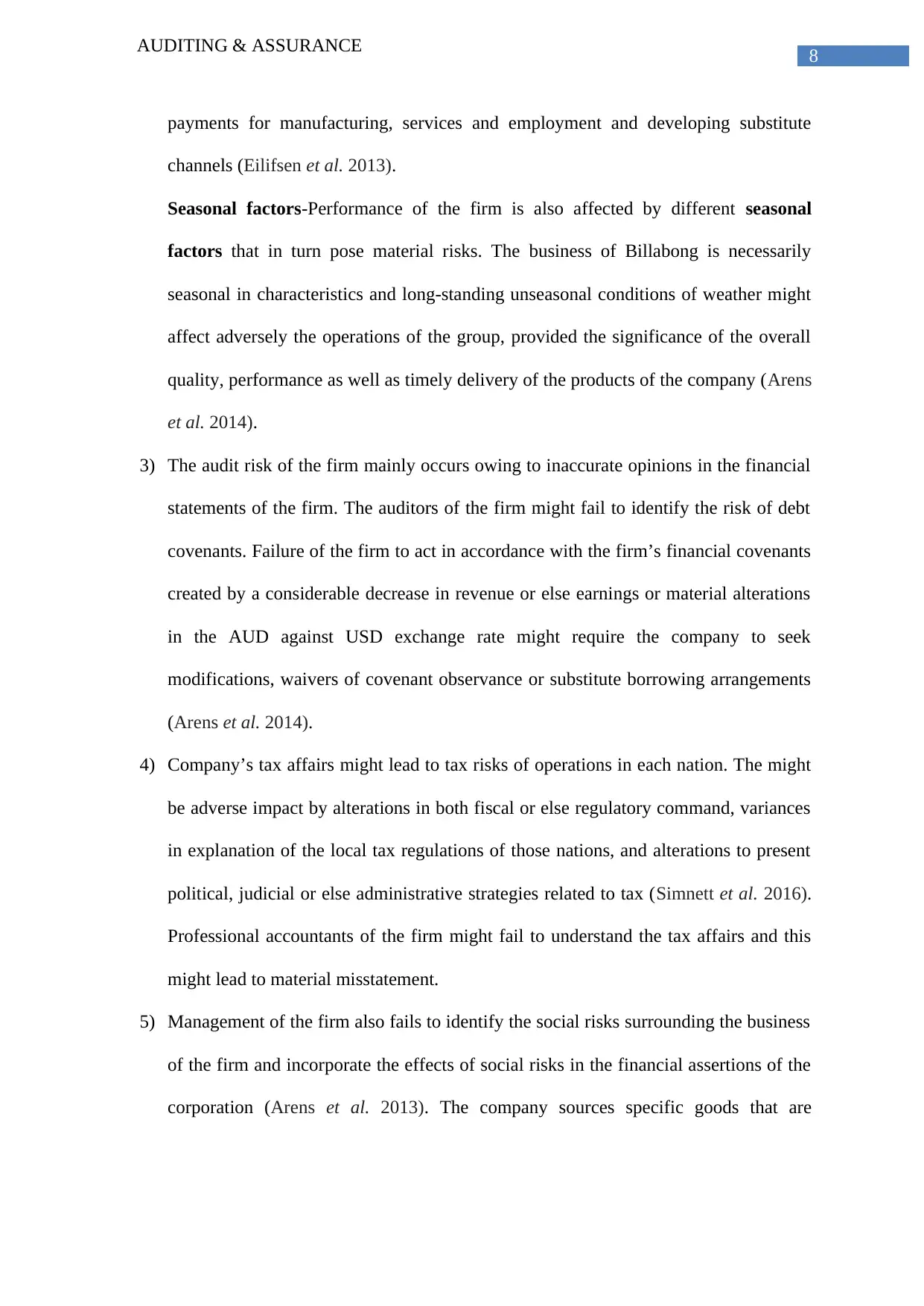
8
AUDITING & ASSURANCE
payments for manufacturing, services and employment and developing substitute
channels (Eilifsen et al. 2013).
Seasonal factors-Performance of the firm is also affected by different seasonal
factors that in turn pose material risks. The business of Billabong is necessarily
seasonal in characteristics and long-standing unseasonal conditions of weather might
affect adversely the operations of the group, provided the significance of the overall
quality, performance as well as timely delivery of the products of the company (Arens
et al. 2014).
3) The audit risk of the firm mainly occurs owing to inaccurate opinions in the financial
statements of the firm. The auditors of the firm might fail to identify the risk of debt
covenants. Failure of the firm to act in accordance with the firm’s financial covenants
created by a considerable decrease in revenue or else earnings or material alterations
in the AUD against USD exchange rate might require the company to seek
modifications, waivers of covenant observance or substitute borrowing arrangements
(Arens et al. 2014).
4) Company’s tax affairs might lead to tax risks of operations in each nation. The might
be adverse impact by alterations in both fiscal or else regulatory command, variances
in explanation of the local tax regulations of those nations, and alterations to present
political, judicial or else administrative strategies related to tax (Simnett et al. 2016).
Professional accountants of the firm might fail to understand the tax affairs and this
might lead to material misstatement.
5) Management of the firm also fails to identify the social risks surrounding the business
of the firm and incorporate the effects of social risks in the financial assertions of the
corporation (Arens et al. 2013). The company sources specific goods that are
AUDITING & ASSURANCE
payments for manufacturing, services and employment and developing substitute
channels (Eilifsen et al. 2013).
Seasonal factors-Performance of the firm is also affected by different seasonal
factors that in turn pose material risks. The business of Billabong is necessarily
seasonal in characteristics and long-standing unseasonal conditions of weather might
affect adversely the operations of the group, provided the significance of the overall
quality, performance as well as timely delivery of the products of the company (Arens
et al. 2014).
3) The audit risk of the firm mainly occurs owing to inaccurate opinions in the financial
statements of the firm. The auditors of the firm might fail to identify the risk of debt
covenants. Failure of the firm to act in accordance with the firm’s financial covenants
created by a considerable decrease in revenue or else earnings or material alterations
in the AUD against USD exchange rate might require the company to seek
modifications, waivers of covenant observance or substitute borrowing arrangements
(Arens et al. 2014).
4) Company’s tax affairs might lead to tax risks of operations in each nation. The might
be adverse impact by alterations in both fiscal or else regulatory command, variances
in explanation of the local tax regulations of those nations, and alterations to present
political, judicial or else administrative strategies related to tax (Simnett et al. 2016).
Professional accountants of the firm might fail to understand the tax affairs and this
might lead to material misstatement.
5) Management of the firm also fails to identify the social risks surrounding the business
of the firm and incorporate the effects of social risks in the financial assertions of the
corporation (Arens et al. 2013). The company sources specific goods that are

9
AUDITING & ASSURANCE
manufactured in nations such as China in which there remain risks revolving safety of
workplace, maintenance of health and safety standards.
AUDITING & ASSURANCE
manufactured in nations such as China in which there remain risks revolving safety of
workplace, maintenance of health and safety standards.
⊘ This is a preview!⊘
Do you want full access?
Subscribe today to unlock all pages.

Trusted by 1+ million students worldwide

10
AUDITING & ASSURANCE
Analysis using financial statements
Calculation of key financial ratio from the financial statements of Billabong
2016 2015 Industry
Current Ratio
Current Assets 464454 523753
Current Liabilities 197932 236768
2.346533 2.212094 2
Debt to Equity Ratio
Debt 185206 113521
Equity 259289 281584
0.714284 0.403151 1
Gross Profit Margin
Gross Profit -23739 2552
Total Sales 11,03,535 10,56,130
-2.15118 0.241637 60%
Inventory Turnover
Cost of Goods Sold 542373 495308
Average Inventory 185556 187125
2.922961 2.646937 4 times
Trade Receivable Turnover
Net Credit Sales 11,03,535 10,56,130
Average Accounts
Receivable
171644 164504
6.429208 6.420087 6 times
AUDITING & ASSURANCE
Analysis using financial statements
Calculation of key financial ratio from the financial statements of Billabong
2016 2015 Industry
Current Ratio
Current Assets 464454 523753
Current Liabilities 197932 236768
2.346533 2.212094 2
Debt to Equity Ratio
Debt 185206 113521
Equity 259289 281584
0.714284 0.403151 1
Gross Profit Margin
Gross Profit -23739 2552
Total Sales 11,03,535 10,56,130
-2.15118 0.241637 60%
Inventory Turnover
Cost of Goods Sold 542373 495308
Average Inventory 185556 187125
2.922961 2.646937 4 times
Trade Receivable Turnover
Net Credit Sales 11,03,535 10,56,130
Average Accounts
Receivable
171644 164504
6.429208 6.420087 6 times
Paraphrase This Document
Need a fresh take? Get an instant paraphrase of this document with our AI Paraphraser
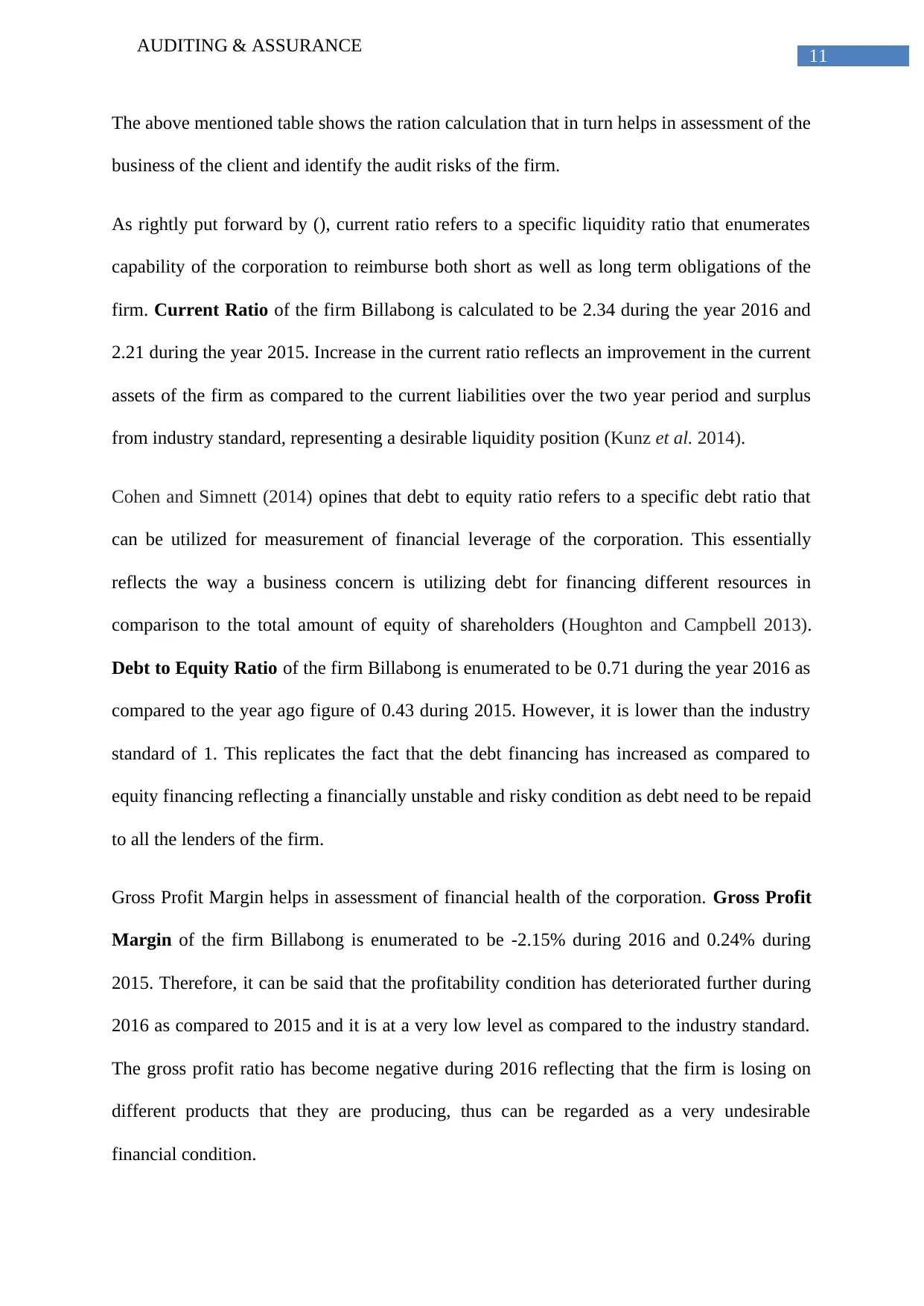
11
AUDITING & ASSURANCE
The above mentioned table shows the ration calculation that in turn helps in assessment of the
business of the client and identify the audit risks of the firm.
As rightly put forward by (), current ratio refers to a specific liquidity ratio that enumerates
capability of the corporation to reimburse both short as well as long term obligations of the
firm. Current Ratio of the firm Billabong is calculated to be 2.34 during the year 2016 and
2.21 during the year 2015. Increase in the current ratio reflects an improvement in the current
assets of the firm as compared to the current liabilities over the two year period and surplus
from industry standard, representing a desirable liquidity position (Kunz et al. 2014).
Cohen and Simnett (2014) opines that debt to equity ratio refers to a specific debt ratio that
can be utilized for measurement of financial leverage of the corporation. This essentially
reflects the way a business concern is utilizing debt for financing different resources in
comparison to the total amount of equity of shareholders (Houghton and Campbell 2013).
Debt to Equity Ratio of the firm Billabong is enumerated to be 0.71 during the year 2016 as
compared to the year ago figure of 0.43 during 2015. However, it is lower than the industry
standard of 1. This replicates the fact that the debt financing has increased as compared to
equity financing reflecting a financially unstable and risky condition as debt need to be repaid
to all the lenders of the firm.
Gross Profit Margin helps in assessment of financial health of the corporation. Gross Profit
Margin of the firm Billabong is enumerated to be -2.15% during 2016 and 0.24% during
2015. Therefore, it can be said that the profitability condition has deteriorated further during
2016 as compared to 2015 and it is at a very low level as compared to the industry standard.
The gross profit ratio has become negative during 2016 reflecting that the firm is losing on
different products that they are producing, thus can be regarded as a very undesirable
financial condition.
AUDITING & ASSURANCE
The above mentioned table shows the ration calculation that in turn helps in assessment of the
business of the client and identify the audit risks of the firm.
As rightly put forward by (), current ratio refers to a specific liquidity ratio that enumerates
capability of the corporation to reimburse both short as well as long term obligations of the
firm. Current Ratio of the firm Billabong is calculated to be 2.34 during the year 2016 and
2.21 during the year 2015. Increase in the current ratio reflects an improvement in the current
assets of the firm as compared to the current liabilities over the two year period and surplus
from industry standard, representing a desirable liquidity position (Kunz et al. 2014).
Cohen and Simnett (2014) opines that debt to equity ratio refers to a specific debt ratio that
can be utilized for measurement of financial leverage of the corporation. This essentially
reflects the way a business concern is utilizing debt for financing different resources in
comparison to the total amount of equity of shareholders (Houghton and Campbell 2013).
Debt to Equity Ratio of the firm Billabong is enumerated to be 0.71 during the year 2016 as
compared to the year ago figure of 0.43 during 2015. However, it is lower than the industry
standard of 1. This replicates the fact that the debt financing has increased as compared to
equity financing reflecting a financially unstable and risky condition as debt need to be repaid
to all the lenders of the firm.
Gross Profit Margin helps in assessment of financial health of the corporation. Gross Profit
Margin of the firm Billabong is enumerated to be -2.15% during 2016 and 0.24% during
2015. Therefore, it can be said that the profitability condition has deteriorated further during
2016 as compared to 2015 and it is at a very low level as compared to the industry standard.
The gross profit ratio has become negative during 2016 reflecting that the firm is losing on
different products that they are producing, thus can be regarded as a very undesirable
financial condition.
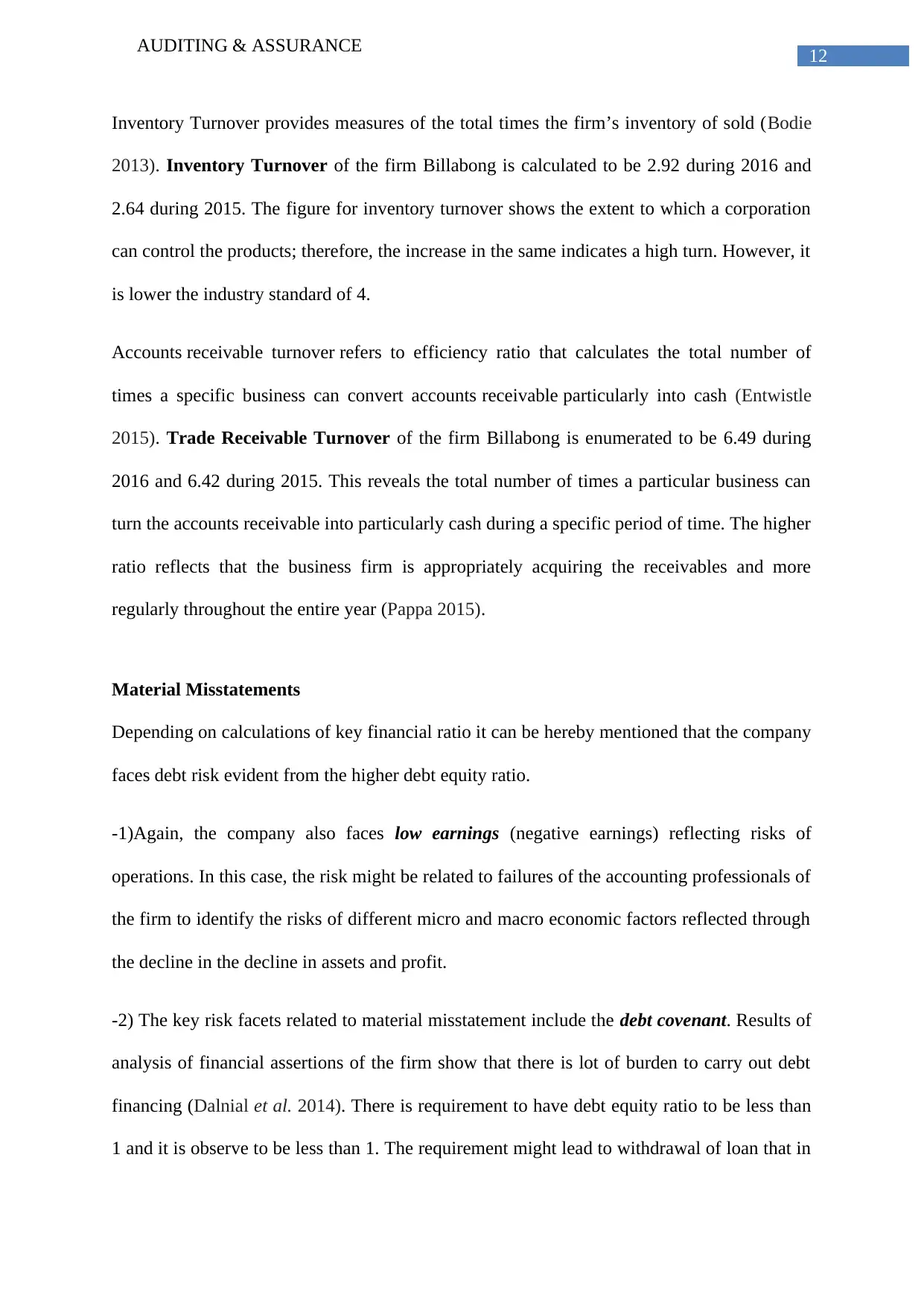
12
AUDITING & ASSURANCE
Inventory Turnover provides measures of the total times the firm’s inventory of sold (Bodie
2013). Inventory Turnover of the firm Billabong is calculated to be 2.92 during 2016 and
2.64 during 2015. The figure for inventory turnover shows the extent to which a corporation
can control the products; therefore, the increase in the same indicates a high turn. However, it
is lower the industry standard of 4.
Accounts receivable turnover refers to efficiency ratio that calculates the total number of
times a specific business can convert accounts receivable particularly into cash (Entwistle
2015). Trade Receivable Turnover of the firm Billabong is enumerated to be 6.49 during
2016 and 6.42 during 2015. This reveals the total number of times a particular business can
turn the accounts receivable into particularly cash during a specific period of time. The higher
ratio reflects that the business firm is appropriately acquiring the receivables and more
regularly throughout the entire year (Pappa 2015).
Material Misstatements
Depending on calculations of key financial ratio it can be hereby mentioned that the company
faces debt risk evident from the higher debt equity ratio.
-1)Again, the company also faces low earnings (negative earnings) reflecting risks of
operations. In this case, the risk might be related to failures of the accounting professionals of
the firm to identify the risks of different micro and macro economic factors reflected through
the decline in the decline in assets and profit.
-2) The key risk facets related to material misstatement include the debt covenant. Results of
analysis of financial assertions of the firm show that there is lot of burden to carry out debt
financing (Dalnial et al. 2014). There is requirement to have debt equity ratio to be less than
1 and it is observe to be less than 1. The requirement might lead to withdrawal of loan that in
AUDITING & ASSURANCE
Inventory Turnover provides measures of the total times the firm’s inventory of sold (Bodie
2013). Inventory Turnover of the firm Billabong is calculated to be 2.92 during 2016 and
2.64 during 2015. The figure for inventory turnover shows the extent to which a corporation
can control the products; therefore, the increase in the same indicates a high turn. However, it
is lower the industry standard of 4.
Accounts receivable turnover refers to efficiency ratio that calculates the total number of
times a specific business can convert accounts receivable particularly into cash (Entwistle
2015). Trade Receivable Turnover of the firm Billabong is enumerated to be 6.49 during
2016 and 6.42 during 2015. This reveals the total number of times a particular business can
turn the accounts receivable into particularly cash during a specific period of time. The higher
ratio reflects that the business firm is appropriately acquiring the receivables and more
regularly throughout the entire year (Pappa 2015).
Material Misstatements
Depending on calculations of key financial ratio it can be hereby mentioned that the company
faces debt risk evident from the higher debt equity ratio.
-1)Again, the company also faces low earnings (negative earnings) reflecting risks of
operations. In this case, the risk might be related to failures of the accounting professionals of
the firm to identify the risks of different micro and macro economic factors reflected through
the decline in the decline in assets and profit.
-2) The key risk facets related to material misstatement include the debt covenant. Results of
analysis of financial assertions of the firm show that there is lot of burden to carry out debt
financing (Dalnial et al. 2014). There is requirement to have debt equity ratio to be less than
1 and it is observe to be less than 1. The requirement might lead to withdrawal of loan that in
⊘ This is a preview!⊘
Do you want full access?
Subscribe today to unlock all pages.

Trusted by 1+ million students worldwide
1 out of 17
Related Documents
Your All-in-One AI-Powered Toolkit for Academic Success.
+13062052269
info@desklib.com
Available 24*7 on WhatsApp / Email
![[object Object]](/_next/static/media/star-bottom.7253800d.svg)
Unlock your academic potential
Copyright © 2020–2025 A2Z Services. All Rights Reserved. Developed and managed by ZUCOL.





